Aloe vera plants are easier to care for than most people think, and they can grow very well both indoors and outside.
The key is to neglect your plant. Yes, that’s right, just ignore it. Well, you can’t ignore it forever, but the biggest mistake people make is giving it too much attention. This usually results in what I call “killing it with kindness”.
In this detailed guide, I will show you all you need to know: from water, light, and soil, to pest control, fertilizer, and much more.
Quick Aloe Vera Care Overview
| Scientific name: | Aloe vera |
| Classification: | Succulent plant |
| Common names: | Medicinal Aloe |
| Hardiness: | Zones 9-11 |
| Temperature: | 60-85°F |
| Flowers: | Yellow, can bloom year round |
| Light: | Full sun to partial shade |
| Water: | Allow soil to dry out, do not overwater |
| Humidity: | Little to none |
| Fertilizer: | General purpose plant food in spring and summer |
| Soil: | Fast-draining, sandy or gritty soil |
| Common pests: | Mealybugs, scale |
Information About Aloe Vera Plants
Aloe vera, or medicinal aloe, is best known for the healing qualities of the gel. It is very common, and just one of hundreds of different species in the Aloe genus of plants.
This popular succulent is a perennial that’s native to the Arabian Peninsula, but these days it is grown all over the world. If you live in a warm enough climate you can plant it in your garden, otherwise it makes a great houseplant.
Whether you want to grow it for the medicinal benefits, or you simply love the look of the spiky leaves, it’s definitely one that you’ll be able to enjoy for many years to come. My aloe vera plant is over 20 years old, and it’s still growing strong.
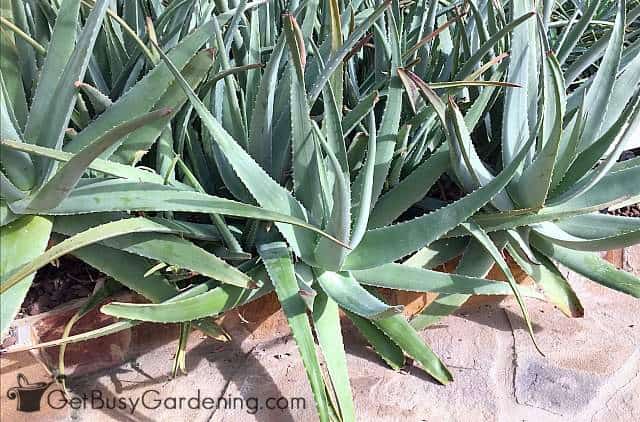
Aloe Vera Plant Benefits
Most people are already very familiar with the medicinal and healing qualities of aloe vera plants. The gel is used in everything from skin and hair care items, to drinks, supplements, and food products.
You can harvest the leaves and gel from your plant and apply it to relieve minor burns and cuts. Or use it to make your own soaps, lotions, and other skin care products if you want.
Another great benefit that many people don’t know about is that growing aloe vera indoors helps to purify the air in your home.
Related Post: How To Store Aloe Vera (Leaves Or Gel)
Where To Grow Aloe Vera
Whether you grow your aloe vera indoors or outside depends on where you live. But either way, choosing the right location is important for them to thrive.
Hardiness
Aloe vera plants are hardy down to zone 9a, and grow best in arid climates. Though they can handle short bursts of freezing temps, they will eventually die if it stays cold for too long.
If you live in a cooler region, or someplace tropical where it rains a lot, then you must move yours indoors during the winter or wet months.
Location
The best location to grow an aloe vera plant is somewhere sunny and dry. Outdoors, plant it in a spot where the soil is very sandy and well-draining. Indoors place your potted plant in a bright, south-facing window.
Though you could keep it inside year-round, you can put it outside during the hot and sunny months. Just make sure the pot has drainage holes, and bring it back indoors before it drops below 60°F in the fall.
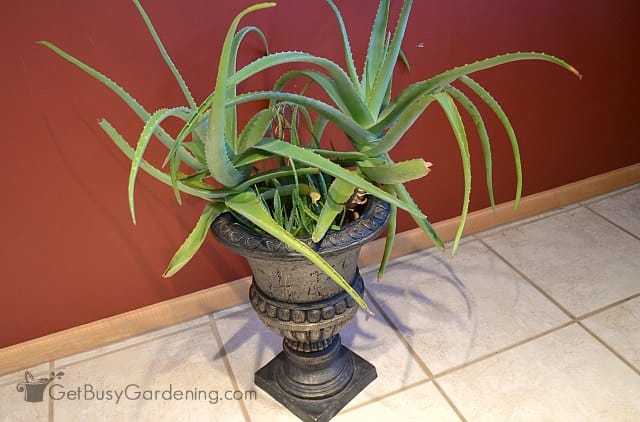
Aloe Vera Plant Care & Growing Instructions
The good news is that aloe vera plants are simple to grow, and they will thrive with minimal care. But, there are a few things you need to do to keep your plant healthy. Follow my tips below for the best success.
Water
The biggest mistake people make when it comes to aloe vera plant care is overwatering. In fact, it’s their #1 killer.
Too much moisture will cause root and stem rot, eventually killing the whole plant from the bottom up. To prevent that from happening, allow the soil to dry out completely between drinks.
Press your finger at least 2 inches deep to make sure it’s completely dry before watering again. If you struggle with this, I highly recommend getting a moisture gauge to help you get it right.
Learn everything you need to know about how to properly water your aloe vera plant here.
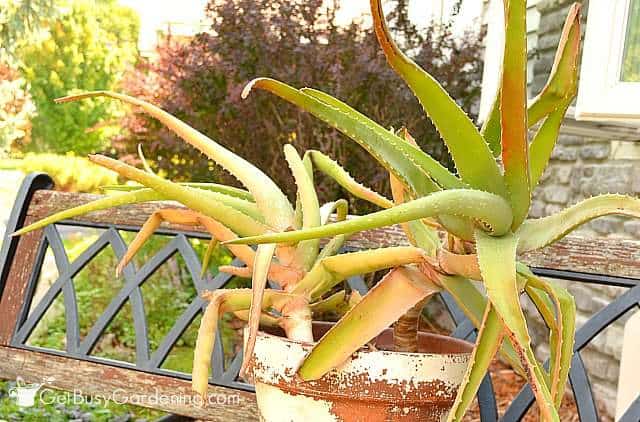
Light
Though they will tolerate partial shade outdoors, aloe vera grows best in a full sun location. If it gets enough sunlight, the leaves can turn a lovely shade of pink, and tall, yellow flower spikes will form.
On the other hand, if they don’t get enough, the plant will become tall and leggy over time. This can be a challenge indoors, so put it in a sunny south-facing window. If your home is too dark, then you should definitely get a grow light.
Related Post: How To Make DIY Aloe Vera Gel At Home
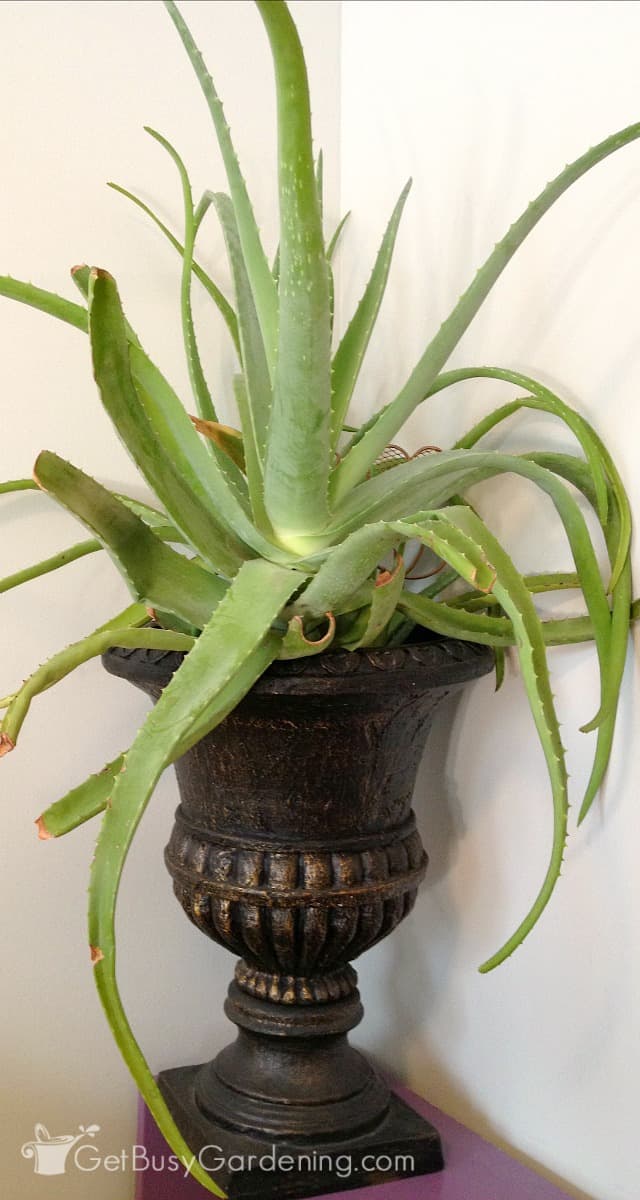
Soil
The best soil for aloe vera is a loose medium that drains very quickly. Use a sandy potting soil, or you could try a gritty mix if you tend to overwater.
I like to make my own, using a mix of perlite or pumice, coarse sand, and regular potting soil, which tends to be cheaper than buying the commercial stuff.
Related Post: How To Make Your Own Succulent Soil (With Recipe)
Repotting
The good news is that you won’t need to repot your plant very often, they like to be root-bound. When the time comes, use a container with drainage holes in the bottom, and only go up one or two sizes.
Planters made out of unsealed terracotta or clay are the best for growing aloe vera, and will wick water out of the soil, helping it dry out faster. Get my step by step instructions for how to repot your aloe vera plant here.
Fertilizer
Aloe vera plants don’t really need to be fertilized. But it will help encourage faster growth and blooming. I recommend using organic products rather than chemicals, especially if you plan to harvest the gel.
Apply a general purpose liquid monthly, or top-dress with slow-release granules once or twice during spring and summer.
Aloes go into a state of dormancy in the winter, and will hardly grow at all. So, don’t feed your plant during the fall and winter months to let them rest.
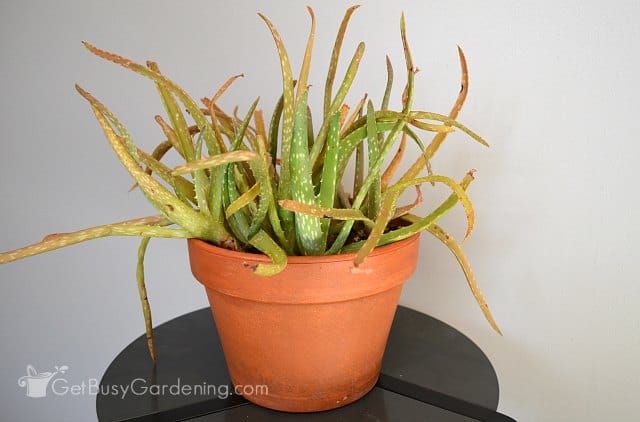
Pest Control Tips
Healthy aloe vera plants rarely have issues with insect pests, but sometimes mealybugs or scale can become a problem.
For small infestations, use a cotton swab soaked in rubbing alcohol to remove any visible bugs. For larger outbreaks, treat your plant with neem oil or an insecticidal soap.
But aloes can be sensitive to certain sprays. So, be sure to test anything you use on a small part of a leaf before treating the whole plant.
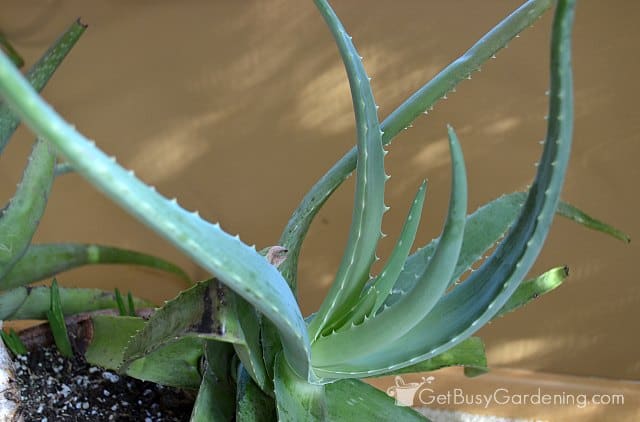
Propagating Your Aloe Vera
It’s easiest to propagate aloe vera plants by division. But if your plant has gotten very long and leggy, and you’re feeling brave, you could try rooting the stem cutting.
This technique can be much more difficult, but it’s fun to try. Simply let the wound cure (dry out) for several days so it calluses over. Then dust it with rooting hormone, and stick it in a dry, sandy medium.
Get my full step-by-step instructions for how to propagate aloe vera by division here.
Troubleshooting Aloe Vera Care Common Problems
Though aloe vera is usually pretty easy to care for, at some point you might start having issues with it. Below are a few of the most common problems, and what to do about them.
Plant Is Tall & Leggy
When an aloe vera grows tall and leggy, that means it’s not getting enough light. They do best with at least 6 hours of full sun per day. If yours is indoors, move it to a south-facing window, or add a grow light.
Mushy Stem
If the stem is completely mushy, that means it was overwatered at some point, and now it’s rotting at the base. Unfortunately there’s not much you can do to fix it.
But you can try saving your plant by cutting it off just above the mushy stem section and rooting it. Make sure you cut off all of the rot though, or it will continue to spread.
Brown Leaves Or Tips
If the brown leaves are drying out and shriveling up, that usually means your aloe vera is not getting enough water. In that case, you can just prune off the dead leaves and water it a little more often.
But if the leaves are mushy and brown, then it’s probably from too much moisture or humidity. So check the soil to make sure it’s not wet, then slow down on watering.
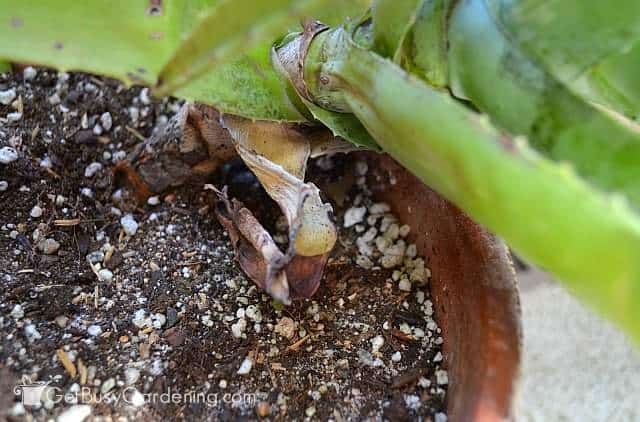
FAQs
Aloe veras can grow pretty fast outdoors in the right climate, but are much slower indoors. If you want yours to grow faster, try putting it outside during the summer, and give it some organic fertilizer.
Leaving the brown tips on your aloe vera won’t hurt the plant. But you can prune them off at any time if you don’t like the way they look.
A healthy aloe vera plant has thick, firm leaves that stand up tall and form tight rosettes. They should also be blueish-green in color (though it’s normal for the leaves to turn yellowish, pink, or orange in the full sun).
Caring for aloe vera is very low-maintenance because these tough plants thrive on neglect. Once you get the hang of giving it exactly what it needs, your plant will thrive for decades to come.
If you want to learn all there is to know about maintaining healthy indoor plants, then you need my Houseplant Care eBook. It will show you everything you need to know about how to keep every plant in your home thriving. Download your copy now!
Share your aloe vera plant care and growing tips in the comments section below.
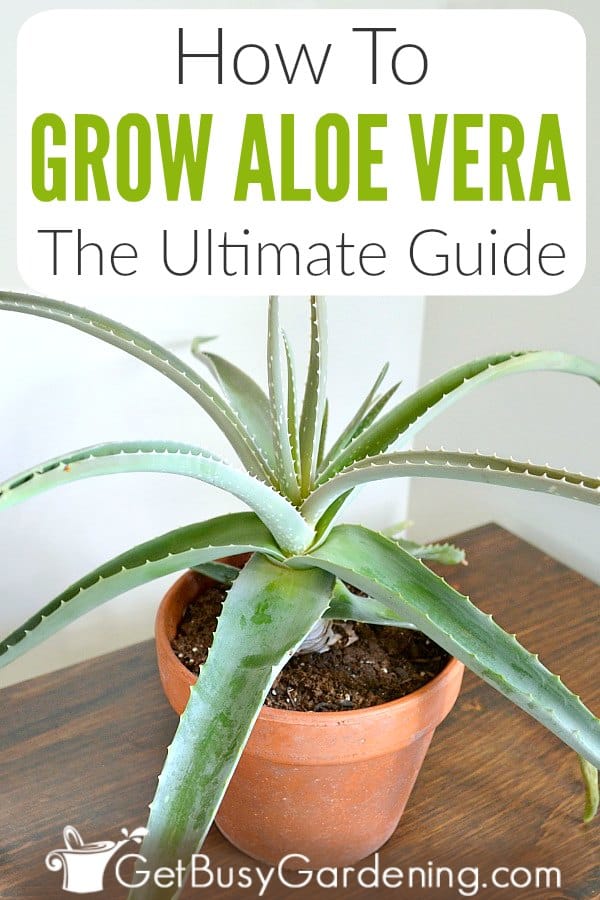
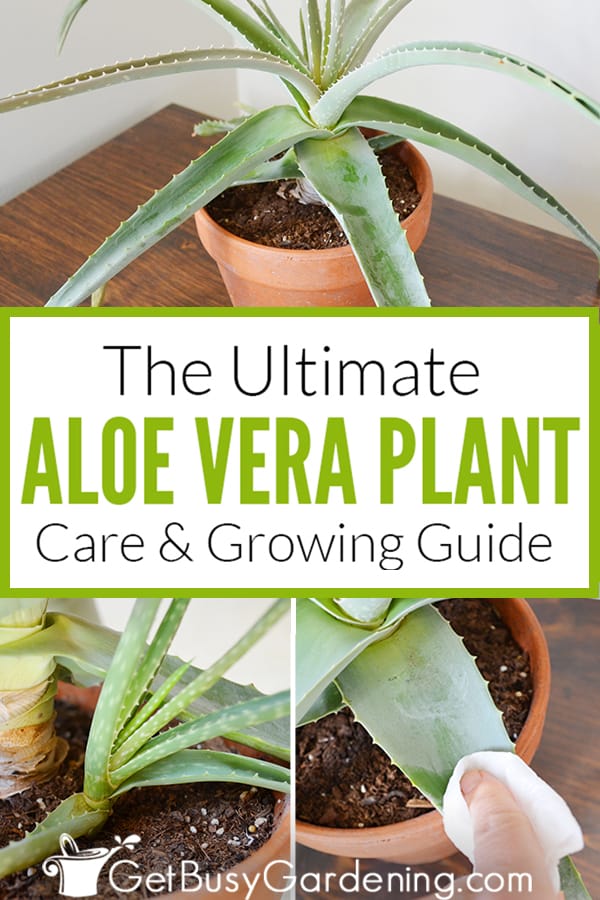
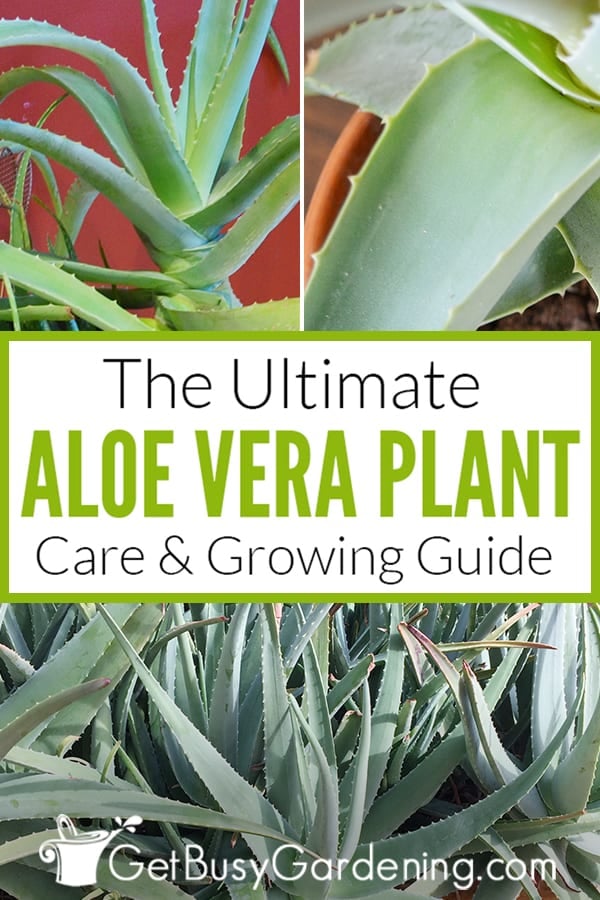
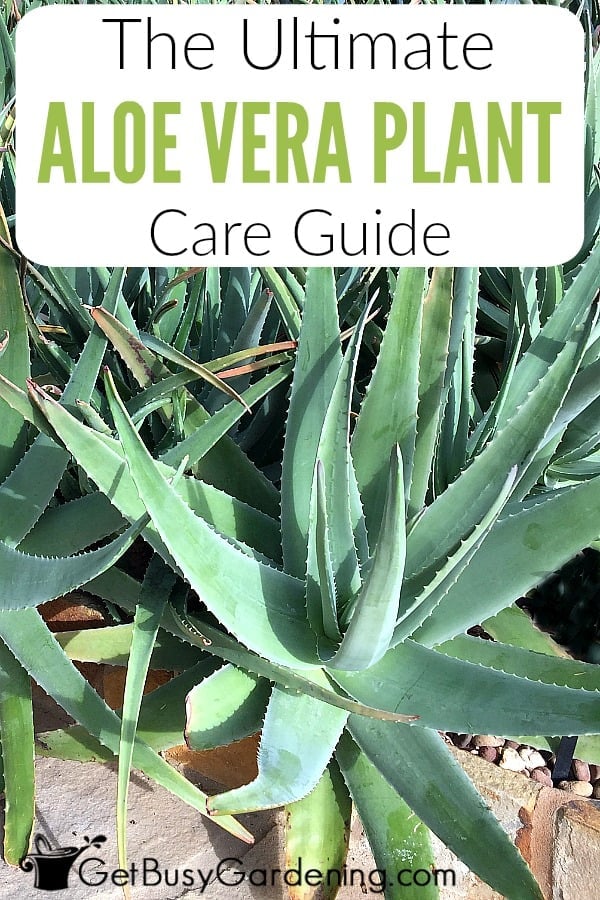
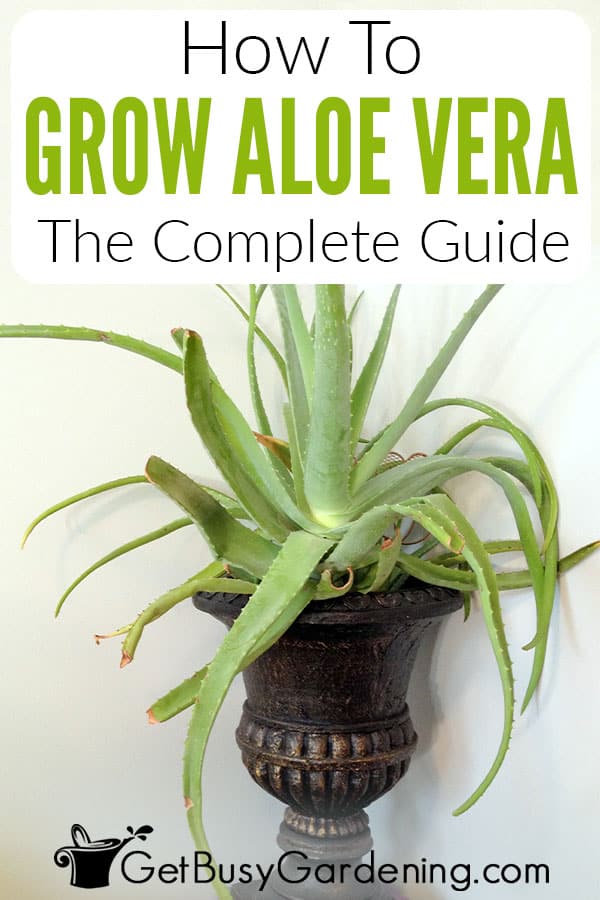
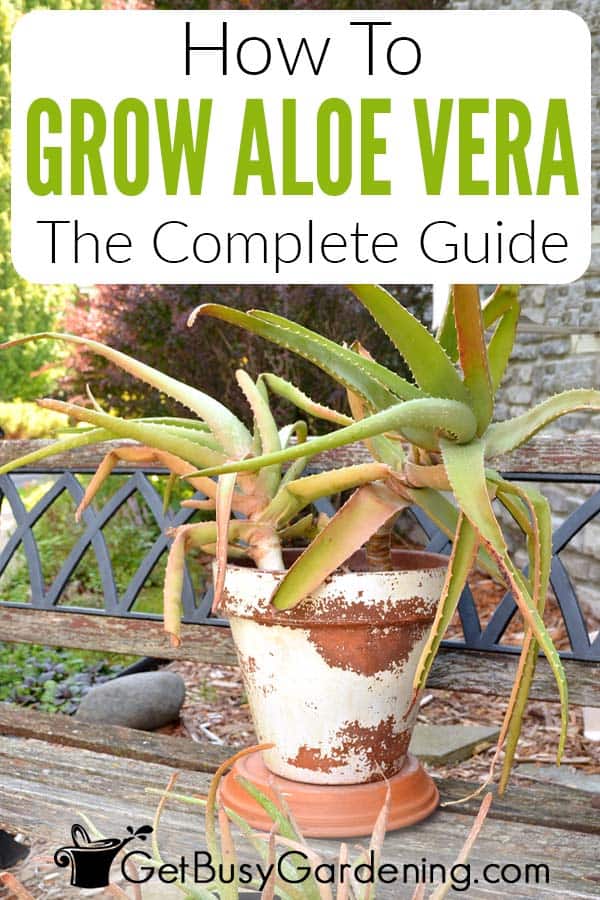
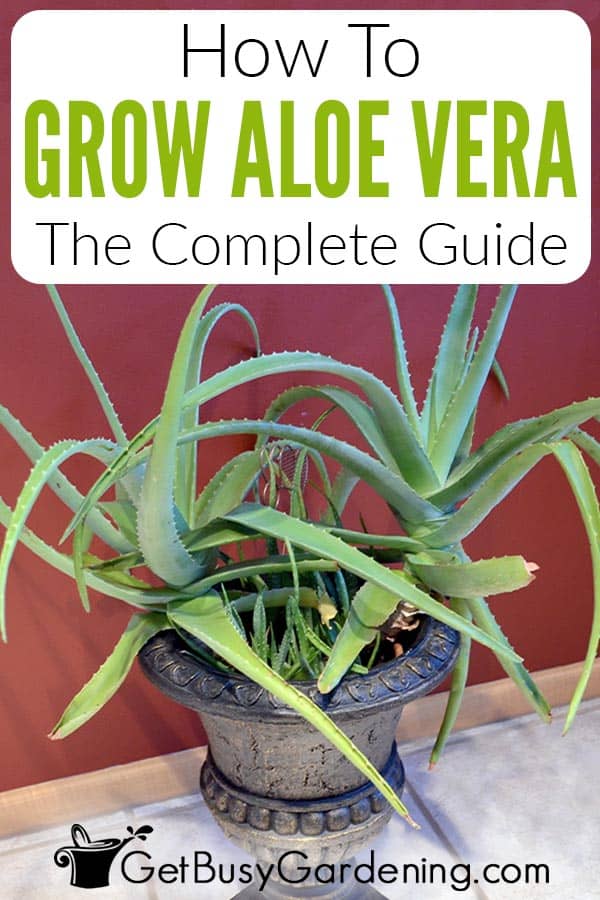
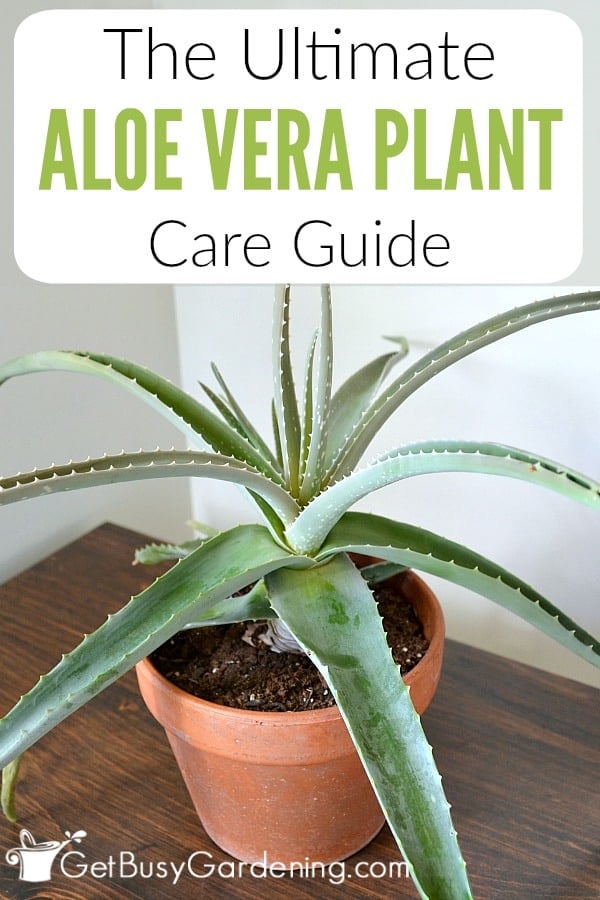
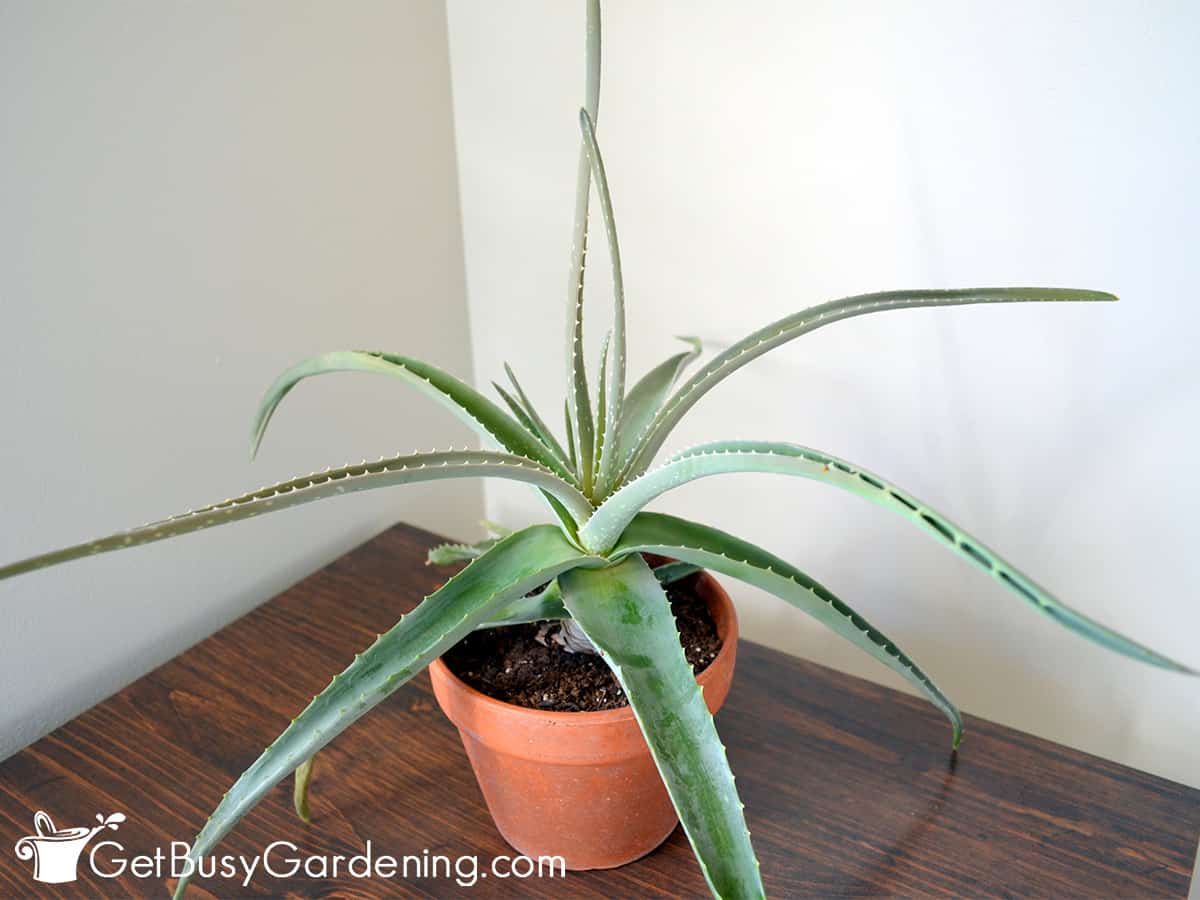




Elly Greenman says
Recently received my Aloe Vera plant in a gallon sized container. I plan to transfer to a gallon sized terracota container. Before I do that, I noticed that a couple of the stems seem loose and feels like they could come right out. Is there something I should do or just pull it out. Plant is not overwatered.
Amy Andrychowicz says
The stems could be loose if the soil is bone dry, or the plant is overly pot-bound. I would just pull the whole thing out of the pot and then loosen up the roots to make sure there’s no rot before planting it in the fresh soil.
Judy says
I cut off the brown end of my aloe and it’s now turning brown down the leaf
Amy Andrychowicz says
If the brown leaf is mushy, then your aloe plant is getting too much water. If the brown leaf is dry and brittle, then it’s not getting enough. Either way, you can just cut the brown leaf off the plant, then adjust your watering habits accordingly. Here’s how to properly water your aloe vera plant.
Diana says
My Aloe Has bloomed twice for me. A tall stem comes up with white flowers on it and so beautiful.
I put it on our deck in the summer time and bring it in to our inside in the winter. One time I had some baby spiders from leaving it outside. haha
We live in Illinois.
Amy Andrychowicz says
Awesome to hear your aloe has bloomed for you before, so fun!
Debra Woolcox says
My Aloe looks good, but the stems are a little soft. The soil is dry. Should I take the Aloe out of the pot, check the roots and cut off any brown ones, then repot in fresh soil, and wait a few days to water it?
Amy Andrychowicz says
There’s no need to repot your aloe unless it has completely outgrown the pot. If the soil won’t hold moisture for very long, that could be what’s causing the leaves to soften, and also a sign that it’s pot-bound. The best time of the year to repot it is in the spring, so I would wait until then.
Elizabeth says
I got a moisture gauge for my indoor, small aloe plant- because I am ethier over or under watering…
The steam seems strong but the leaves seem limp and almost dry? like there’s spots that don’t have any gel innards.
Should I be letting the gauge get to 1(red zone) before re-watering?
When I re-watered with the gauge it was at 1 jumped to 7-8(green) but was back down to 2 or 3 within a couple hours… did I not give enough water? Should I add more or just leave it?
Sorry I am a complete newbie!
Amy Andrychowicz says
As long as you have the same gauge as I recommend in the article, it should read between 1-3 (in the red zone) before you water again. Since the reading was so different in just a few short hours, it’s likely the soil isn’t evenly moist, and that’s normal since you just watered it because it hadn’t fully soaked in yet. Brown tips are an indication that it hasn’t gotten enough moisture over time, and that problem will eventually go away once you get the hang of how much it needs. You can just prune off the dead tips, since those won’t grow back.
Elizabeth says
Yes I did get the gage you recommended!
So after I water what zone/number should it be in once the soil has gotten evenly moist?
Thank you for your help!
Amy Andrychowicz says
You don’t need to worry about using the moisture gauge after watering, it’s just a tool you use so you know when it’s time to water. For Aloes, when the gauge reads close to the 1-2 range, it’s time to water. To do that, pour it over the top of the soil until it starts to flow out of the drainage holes, then stop and let it drain away completely. Then check it every few weeks after that to see when it’s time for more.
Dorothy says
How do I get my aloe to bloom.
Amy Andrychowicz says
Aloe vera needs to be outdoors in the full sun in order to bloom, it’s very uncommon for them to flower indoors. Feeding it regularly during the growing season will help too. However, you only said “aloe” in your question, so if you have a different variety then you may see flowers indoors. I have several other species of aloes that bloom every year after I bring them back indoors in the fall.
Jan says
My aloes have grown extremely long root stems, I’m guessing from where earlier leaves have fallen off. The stems have grown so long that they can’t support the plants. How do I cut the stems and repot without killing the plants? Please respond to my email address as I’m sure I won’t be able to track your reply in this article.
Amy Andrychowicz says
You can cut the entire top off of your leggy aloes and root them, just like any other cutting. Simply dip the stem in rooting hormone, and place it into a sandy soil mixture. Keep the soil dry and the air humid, and roots should start to form in a few months. The old stem won’t grow anymore, but new babies will from around the base, so leave it in the pot if you’d like to try that too. Good luck!
Mary Starr says
My sister is growing an aloe.. she asked me what to do about the leaves growing sideways… she wants the plant to grow up and not out. my plants just grow, so I didn’t know what to tell her?
Amy Andrychowicz says
Humm… I’m not exactly sure what to tell her either. The natural growth habit of aloe vera is that the larger more mature leaves on the bottom open up wide, while the smaller new ones will point upward. If she means to say that hers is leggy and reaching to one side, then that means it needs more light to get it to grow straight up. Hopefully that answers her question. 🙂
Michael Clark says
In November 2017 I started to look after a friend’s aloe when she moved to Shanghai. She’d had it about six years.and it used to have five or six leaves, never very long. I kept it on my balcony in Shenzhen which doesn’t get any direct sunlight.
Most days I would finish the evening with a few cans of Tsing Tao beer, and drain the meagre dregs into the aloe pot when doing my recycling. By June 2018 the aloe was thriving with eight leaves, much longer than previously. I continued this until I was ejected from China in October 2021. By this time the aloe was nearly three feet across with uncountable leaves. I have some pics if anyone is interested.
Amy Andrychowicz says
Wow, wonderful! I guess your friend’s aloe vera really liked the unique care you were giving it!
Kenia Medina says
I have a small aloe plant that was doing good until I repotted it. The main large leaves are very droopy and I’m not sure what to do! It’s been about 2 weeks now since I repotted. Thanks!
Amy Andrychowicz says
Oh no, sorry to hear your aloe plant is droopy. Check that the leaves are firm and not mushy. If they are mushy and rotting, cut them off. Then check the base of the stem to make sure it’s not rotting. Make sure to let the soil dry completely between waterings, ensure there are holes in the bottom of the pot, and check that you used a sandy, fast-draining soil when you repotted.
Brittani says
I have a small aloe vera plant, growing it indoors. My son bent one of the leaves… What should I do with it? Cut it off at the bent part? It’s just hanging there. I’m afraid to cut it but also afraid to leave it because I’m afraid it’ll die either way!! Can you help? 🥴 Thanks!
Amy Andrychowicz says
You can either cut the broken aloe leaf off at the bend, or clip it all the way back to the main stem. The broken leaf will never grow again, so it really depends on how you want it to look. If the look of the cut leaf sticking out bothers you, then trim it all the way back.
Jennifer Rooney says
I have an aloe plant that seems to be doing well but it isn’t very bushy/doesn’t have a ton of leaves. What can I do to encourage my aloe to grow out rather than up~to grow more leaves essentially. Will 6-12-6 fertilizer sticks work for this? Thanks in advance!!
Amy Andrychowicz says
Make sure your aloe vera is getting plenty of light, full sun outside or supplement with a grow light indoors. That’s the best way to get it to fill in better. If you want to try fertilizer, I recommend only using natural, organic options like I listed above, and not chemical brands.
Bree says
For some reason my aloe plant unfit and outdoor plant has brown blackish spots on them what could this be
Amy Andrychowicz says
Black spots on your aloe vera could be from a fungal disease, but most like it’s due to overwatering or lack of light. Make sure the soil dries completely before adding more water, and put it in the full sun (if it’s currently in the shade, slowly acclimate it to a full sun location though, or it could burn the leaves).